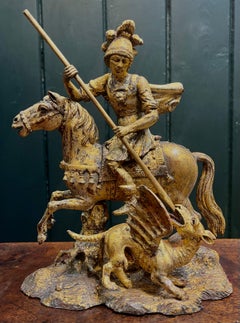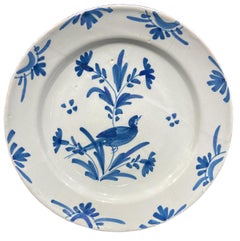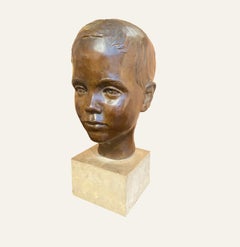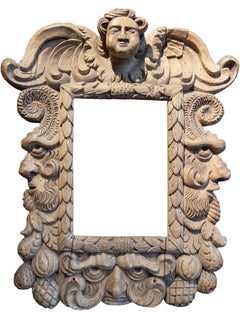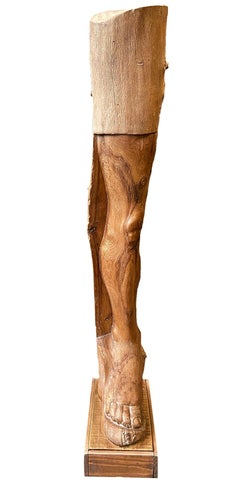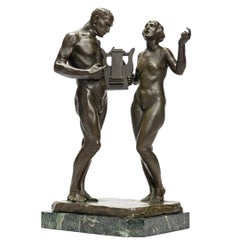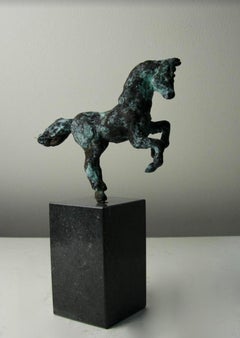Darnley Fine Art Figurative Sculptures
to
7
2
1
Overall Width
to
Overall Height
to
3
2
5
2
2
5
5
5
4
2
1
1
1
1
1
1
1
1
1
1
1
1
1
4
3
3
3
2
10
St George Slaying the Dragon
Located in London, GB
18th Century European School
St George Slaying the Dragon
Wood, gilded
8 inches in height, 6 3/4 x 4 inches base
This 18th century carved and gilt wood statuette depicts the moment ...
Category
18th Century Figurative Sculptures
Materials
Wood
Price Upon Request
Head of Dame Edith Sitwell
Located in London, GB
Maurice Lambert
Head of Dame Edith Sitwell
1901-1964
Patinated bronze on marble base
Dimensions: 7 x 16 inches (18 x 41 cm)
Provenance
Private collection
Originally commissioned by Edith's brother Osbert Sitwell circa 1926/27. Our version is of the same period and must have been commissioned at the same time. A version of this piece made in 1984 in aluminium is held in the permanent collection of the National Portrait Gallery (NPG 5801).
Maurice Lambert
Maurice Lambert, born in Paris, was son of the Russian-born Australian painter George Washington Lambert...
Category
20th Century Modern Figurative Sculptures
Materials
Marble, Bronze
Lambeth Plate, English Delftware, Blue and White Design c. 1750
Located in London, GB
English Delftware blue and white plate, painted with a flower and bird design
Diameter: 8 3/4 inches (22.25 cm)
Delftware is also known as Delft Blue, was originally a general term ...
Category
1750s Sculptures
Materials
Ceramic, Delft
Bronze Head of a Young Boy, Early 20th Century English Sculpture
Located in London, GB
English School
Early 20th Century
Head of a Young Boy
Bronze with stone base
Height: 12 3/4 inches (32.5 cm)
Category
Early 20th Century Figurative Sculptures
Materials
Stone, Bronze
Hand Carved Wooden Frame, 16th Century European School
Located in London, GB
Hand Carved Fruit Wood
Length: 16 inches (40.5 inches)
A striking, richly hand carved frame in high relief. It shows a rich decor of natural organic forms alongside a collection of ...
Category
16th Century Figurative Sculptures
Materials
Wood
Price Upon Request
Wooden Maquette of a Leg, Hand Carved British Sculpture
Located in London, GB
Hand-carved wooden trunk and plinth
Height: 38 1/2 inches (98 cm)
Width: 10 1/2 inches (27 cm)
Lawson Rudge
Lawson Rudge was born in 1936. He is...
Category
20th Century Realist Figurative Sculptures
Materials
Wood
Price Upon Request
Nude Statue, 20th Century Carved Oak
Located in London, GB
Carved Oak, 20th Century European School Nude Statue
Height: 21 3/4 inches
Category
20th Century Modern Figurative Sculptures
Materials
Oak
Wolfgang Amadeus Mozart, 18th Century Half Length Sculpture
Located in London, GB
Plaster, raised pins and later coloured to simulate terracotta
Height: 32 3⁄4 inches (83.5 cm).
Full of elegance and liveliness, it conveys the consummate ability of the artist. Be...
Category
19th Century Academic Figurative Sculptures
Materials
Plaster
Reclining Figure Carved Marble Early 20th Century France
Located in London, GB
Circle of Henri-Gaudier-Breska
1891-1915
Reclining Figure
Carved marble
Height 5 inches
Born Henri Alphonse Séraphin Marie Gaudier near Orléans in France, Gaudier-Brzeska started using his hyphenated name in 1910 when he met the Polish writer Sophie Brzeska. They moved to London together in January 1911 and adopted their new names and the identity of brother and sister in order to make their cohabitation respectable.
Gaudier-Brzeska started to establish himself as a sculptor in 1912. Initially influenced heavily by Rodin, he later assimilated more influences from the modernist movement of cubism and from examples of non-European art he saw in London’s museums. He met the sculptor Jacob Epstein in June 1912, who further encouraged him to break with classical Greek tradition.
While working from 25 Winthorpe Road in 1913–14, Gaudier-Brzeska became increasingly involved in London’s avant-garde art scene. He exhibited at the London Salon in July 1913, where he met the poet and arts patron Ezra Pound. Pound described Brzeska as ‘like a well-made young wolf or some soft-moving, bright-eyed wild thing’. Gaudier-Brzeska subsequently became associated with the vorticist movement led by Wyndham Lewis, contributing two important articles to Lewis’s magazine Blast and signing his name against the vorticist manifesto.
He was also a founding member of the London Group, which formed when the all-male Camden Arts Group joined with independent artists to challenge the dominance of the Royal Academy of Arts. Other founding members included Walter Sickert, Robert Bevan and Spencer Gore...
Category
Early 20th Century Figurative Sculptures
Materials
Marble
Bust of Frederick William Walker, 19th Century Figurative Sculpture
Located in London, GB
Hope-Pinker was born in Peckham, Surrey, the son of a stonemason and builder employing 5 or 6 men c.1871 in Hove, Sussex, who seems to have taught his son much of his stone-carving skills, although he also attended the Royal Academy Schools (c.1871). Hope-Pinker typically carved without a model from drawings. The bulk of his work was portrait sculpture and John Hunter...
Category
19th Century English School Figurative Sculptures
Materials
Bronze
Related Items
Harmony, 20th century bronze & green marble base, nude man and woman with lyre
By Max Kalish
Located in Beachwood, OH
Max Kalish (American, 1891-1945)
Harmony, c. 1930
Bronze with green marble base
Incised signature on right upper side of base
14 x 9 x 5 inches, excluding base
17 x 10 x 8 inches, including base
Born in Poland March 1, 1891, figurative sculptor Max Kalish came to the United States in 1894, his family settling in Ohio. A talented youth, Kalish enrolled at the Cleveland Institute of Art as a fifteen-year-old, receiving a first-place award for modeling the figure during studies with Herman Matzen. Kalish went to New York City following graduation, studying with Isidore Konti...
Category
1930s American Modern Figurative Sculptures
Materials
Marble, Bronze
$10,450
H 17 in W 10 in D 8 in
Davinci's Horse Rears by Helle Crawford, Bronze sculpture of a horse
By Helle Rask Crawford
Located in DE
Bronze sculpture of a horse that rears on granite base
Category
21st Century and Contemporary Contemporary Figurative Sculptures
Materials
Granite, Bronze
$1,066
H 8.67 in W 5.52 in D 2.37 in
Kneeling Female Nude, Bronze By Mario Korbel
Located in Norwood, NJ
Joseph Mario Korbel (Czech/American, 1882-1954). Period fine example bronze, dark brown patina, modeled as a nude female kneeling and tying her sandal, raised on a stepped black marb...
Category
Early 20th Century Art Deco Figurative Sculptures
Materials
Marble, Bronze
Pair of Porphyry Marble Columns with Gilt Bronze Capitals, 19th Century
Located in Beachwood, OH
Pair of Porphyry Marble Columns with Gilt Bronze Capitals, 19th Century
Porphyry marble & gilt bronze
20 x 4.25 x 4.25 inches
Porphyry is an igneous rock, not marble, known for its...
Category
19th Century Figurative Sculptures
Materials
Marble, Bronze
$6,750
H 20 in W 4.25 in D 4.25 in
Altar boy
Located in Roma, RM
Alfio Castelli (Senigallia 1917 – Rome 1992), Altar boy
Bronze sculpture of 58 x 40 x 20 cm signed lower left.
Category
Mid-20th Century Realist Figurative Sculptures
Materials
Bronze
CRESCENT MOON MADONNA
Located in Wien, Wien
Master in the circle of Michael Pacher
(Mühlen ca. 1435 - 1498 Salzburg)
Salzburg
Around 1480
Carved limewood
Old polychrome version
Height 118 cm
This Madonna is an outstanding ex...
Category
15th Century and Earlier Gothic Figurative Sculptures
Materials
Wood
TRIO AMIGOS (Original and One Of A Kind Disney Sculpture)
By Mauro Oliveira
Located in LOS ANGELES, CA
*New Year Inventory Renewal Sale - 90 Days Until April 30th*
*This Price Won't Be Repeated Again This Year*
TRIO AMIGOS is the collectors' Toy/Disney pieces must have becaus...
Category
21st Century and Contemporary Pop Art Figurative Sculptures
Materials
Glass, Resin, Wood, Glitter, Acrylic, Wood Panel, Plastic
$1,336 Sale Price
31% Off
H 16 in W 24 in D 6 in
Virgin and Child
Located in Wien, Wien
OUTSTANDING MADONNA
Bavaria
Around 1515/20
Lime wood carved
Original, polychrome version
Height 60 cm
This masterfully carved, full-round Madonna was created around 1515-20 in...
Category
16th Century Medieval Figurative Sculptures
Materials
Wood
Listening for Spirit
By Denny Haskew
Located in Loveland, CO
Listening for Spirit by Denny Haskew
Female nude
Bronze (silver nitrate patina) on sandstone 8x6x10" ed/30 (height is variable based on stone)
si...
Category
Early 2000s Contemporary Figurative Sculptures
Materials
Sandstone, Bronze
Bronze Bowl With Marble and Wood Sculpture
Located in Lake Worth Beach, FL
Bronze Marble Wood Sculpture
Four separate pieces, unsigned artist Sarah Schwartz was born 1953 Chicago, Illinois.
Education: 1971-72 York University/Ontario College of Art, Toronto...
Category
1980s American Modern Figurative Sculptures
Materials
Marble, Bronze
Bronze Abstract Space Age Book Sculpture LA California Modernist Charna Rickey
By Charna Rickey
Located in Surfside, FL
Charna Rickey 1923 - 2000 Mexican-American Jewish Woman artist.
Signed Bronze House of Books, Architecture Bronze sculpture, signed Charna Rickey and on the front "House of the book." It depicts an open Torah. Original patina.
Approx. dimensions: 7 in. H x 9 in. W x 8.5 in. D. Weight: 13.1 lbs.
Modernist Judaica Sculpture
Born Charna Barsky (Charna Ysabel or Isabel Rickey Barsky) in Chihuahua, Mexico, the future artist lived in Hermosillo and immigrated to Los Angeles when she was 11. She was educated at UCLA and Cal State L.A., she married furniture retailer David Rickey and explored art while raising their three daughters. Moving through phases in terra cotta, bronze, marble and aluminum, she found success later in life. Rickey became one of the original art teachers at Everywoman's Village, a pioneering learning center for women established by three housewives in Van Nuys in 1963. She also taught sculpture at the University of Judaism from 1965 to 1981.
As Rickey became more successful, her sculptures were exhibited in such venues as Artspace Gallery in Woodland Hills and the Courtyard of Century Plaza Towers as part of a 1989 Sculpture Walk produced by the Los Angeles Arts Council. Her sculptures have also found their way into the private collections of such celebrities as Sharon Stone.
Another of Rickey's international creations originally stood at Santa Monica College. In 1985, her 12-foot-high musical sculpture shaped like the Hebrew letter "shin" was moved to the Rubin Academy of Music and Dance at Hebrew University in Jerusalem. The free standing architectural Judaic aluminum work has strings that vibrate in the wind to produce sounds. Rickey also created art pieces for the city of Brea. They commissioned some amazing art pieces by Laddie John Dill, Walter Dusenbery, Woods Davy, Rod Kagan, Pol Bury, Niki de Saint Phalle, Magdalena Abakanowicz, Larry Bell, John Okulick...
Category
20th Century American Modern Abstract Sculptures
Materials
Marble, Bronze
$2,200
H 7 in W 9 in D 8.5 in
"Case Runner, " Mixed Media Sculpture
Located in Chicago, IL
To Chicago-based artist Patrick Fitzgerald, his sculptures are a means of traveling through time. Working from found materials, Fitzgerald constructs miniature soap box cars...
Category
21st Century and Contemporary Outsider Art Figurative Sculptures
Materials
Wire
